INTRO
REGION
LINKS
SHOPS
EVENTS
|
|
HOME INTRO |
VISIT REGION |
MEDIA LINKS |
TOUR SHOPS |
NEWS EVENTS |
|---|---|---|---|---|---|
EBT Fall Spectacular 1999 / FEBT 17th Reunion | |||||
< Back to the EBTRR Homepage
< Back to the EBTRR Multimedia Archive
Page Contents:
 This is the lower reservoir on Jordan Creek south of the yards. Water
is pumped from here to the Reservoir
Ponds which supply the water to the locomotives.
This is the lower reservoir on Jordan Creek south of the yards. Water
is pumped from here to the Reservoir
Ponds which supply the water to the locomotives.
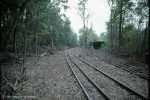 Tree clearing continues in the Mount
Union Yard for Mount Union Connecting
Railroad service.
Tree clearing continues in the Mount
Union Yard for Mount Union Connecting
Railroad service.
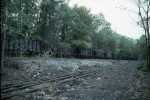 More work by the Mount Union Connecting
Railroad, here at the enginehouse lead.
More work by the Mount Union Connecting
Railroad, here at the enginehouse lead.
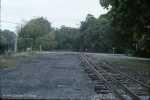 Here is the new tie-in with the NS main. The stubs in the center are the
old creosote plant spur, where the track was cut and moved over to tie
into the EBT yard main.
Here is the new tie-in with the NS main. The stubs in the center are the
old creosote plant spur, where the track was cut and moved over to tie
into the EBT yard main.
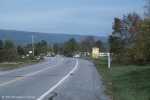 Looking north toward the Riverview Business
Center, clearing on the EBT main is apparent. This clearing was reportedly
done by RBC, but will surely help MTC.
Looking north toward the Riverview Business
Center, clearing on the EBT main is apparent. This clearing was reportedly
done by RBC, but will surely help MTC.
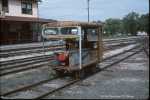 Phil Raynes brought his ex-EBT Fairmont speeder as a display for the weekend
(and put some test miles on it.) The unit is still waiting for some body work,
but the mechanicals look great.
Phil Raynes brought his ex-EBT Fairmont speeder as a display for the weekend
(and put some test miles on it.) The unit is still waiting for some body work,
but the mechanicals look great.
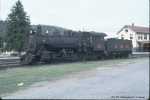 #18 was brought out for the weekend and had all her lettering repainted
and her brass parts shined (except the boiler bands.)
#18 was brought out for the weekend and had all her lettering repainted
and her brass parts shined (except the boiler bands.)
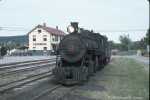 Here's a 3/4 view of #18. Behind her the station and a MOW car are visible.
Here's a 3/4 view of #18. Behind her the station and a MOW car are visible.
 Near the Riverview Business Center in
Allenport, trees have been cleared along the EBT right-of-way.
Near the Riverview Business Center in
Allenport, trees have been cleared along the EBT right-of-way.
 In the foreground is the power cord for her headlight.
In the foreground is the power cord for her headlight.
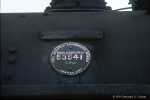 #18's builder's plate was also buffed up, revealing her heritage.
#18's builder's plate was also buffed up, revealing her heritage.
![]() This is a stereo video of M-1 backing out past the
Sand House and giving three
toots from the whistle.
15.6 sec., 0.42 MB.
This is a stereo video of M-1 backing out past the
Sand House and giving three
toots from the whistle.
15.6 sec., 0.42 MB.
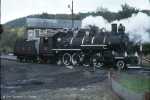 Look at 'dem pearly whites! All four locos received new accent paint.
Here #15 heads out to do a brake test on the passenger train.
Look at 'dem pearly whites! All four locos received new accent paint.
Here #15 heads out to do a brake test on the passenger train.
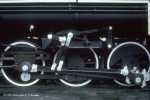 Here is a closeup of #17's unique Southern valve gear. Southern valve gear
is unusual in that there is no connection to the crosshead (the squarish thing
in front of the left wheel).
Here is a closeup of #17's unique Southern valve gear. Southern valve gear
is unusual in that there is no connection to the crosshead (the squarish thing
in front of the left wheel).
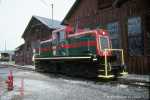 M-7 is over the inspection pit behind the Boiler
Shop getting her truck chains greased and inspected.
M-7 is over the inspection pit behind the Boiler
Shop getting her truck chains greased and inspected.
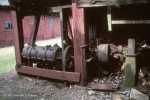 Outside the Foundry are a belt driven tumbler
and grinder. These two items were completely overlooked by the HAER documentation.
Outside the Foundry are a belt driven tumbler
and grinder. These two items were completely overlooked by the HAER documentation.
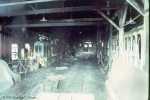 This is a 15 second time exposure of the interior of the
Car Shop. To the right are two of the three D&RGW cars purchased from an amusement
park. The missing benches are now on the EBT's restored flat cars. The third car was
partially rebuilt into a coach but never finished. To the left is a weed sprayer
and tank. To their right is a single truck cabless Davenport switcher and coupler adapters.
In the center distance are the shops machinery. The center track is used to store some of
the active cars.
This is a 15 second time exposure of the interior of the
Car Shop. To the right are two of the three D&RGW cars purchased from an amusement
park. The missing benches are now on the EBT's restored flat cars. The third car was
partially rebuilt into a coach but never finished. To the left is a weed sprayer
and tank. To their right is a single truck cabless Davenport switcher and coupler adapters.
In the center distance are the shops machinery. The center track is used to store some of
the active cars.
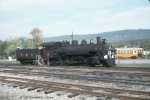 Here is the other side of #18 (minus that annoying pink tape).
Here is the other side of #18 (minus that annoying pink tape).
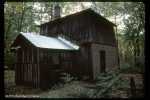 Dusk is covering the landscape between the Allegheny ridge lines as this shot
reveals the repainted rear roof at Coles Tankhouse.
Dusk is covering the landscape between the Allegheny ridge lines as this shot
reveals the repainted rear roof at Coles Tankhouse.
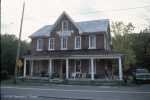 In Saltillo, the LaPalace Hotel continues it's
slow transformation into a bed and breakfast.
In Saltillo, the LaPalace Hotel continues it's
slow transformation into a bed and breakfast.
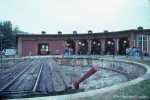 Last call at the Rockhill Roundhouse. It is actually
almost dark, but since the people did not move, you can't tell this is a time exposure.
In #18's stall several MOW cars have been lined up for display the next day.
Last call at the Rockhill Roundhouse. It is actually
almost dark, but since the people did not move, you can't tell this is a time exposure.
In #18's stall several MOW cars have been lined up for display the next day.
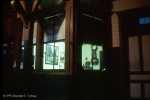 The interior of Orbisonia Station is brightly
illuminated as the staff and crew meet to prepare for the Spectacular in the adjoining
room.
The interior of Orbisonia Station is brightly
illuminated as the staff and crew meet to prepare for the Spectacular in the adjoining
room.
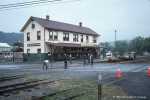 After attempts on Friday for one of the restored MOW cars to pull all four cars
led to mixed results, the four cars were pulled out by the Silver Sightseer
enclosed car (it has a four cylinder instead of a single cylinder). Even she
could not get the cars across the siding crossing of Meadow Street. EBT crew
members are clearing the rarely used flangeways of gravel to allow the 'train'
to pass.
After attempts on Friday for one of the restored MOW cars to pull all four cars
led to mixed results, the four cars were pulled out by the Silver Sightseer
enclosed car (it has a four cylinder instead of a single cylinder). Even she
could not get the cars across the siding crossing of Meadow Street. EBT crew
members are clearing the rarely used flangeways of gravel to allow the 'train'
to pass.
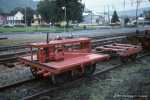 Now in place on the parking siding, these are the two freshly restored cars.
Now in place on the parking siding, these are the two freshly restored cars.
![]() #14 on her way out to pick up the Passenger train whistles
for the crossing and passes the MOW cars, M-1, M-7 and #18.
23.4 sec., 0.63 MB.
#14 on her way out to pick up the Passenger train whistles
for the crossing and passes the MOW cars, M-1, M-7 and #18.
23.4 sec., 0.63 MB.
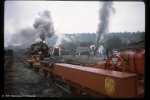 With the MOW cars restored last year in the foreground and those restored this
year in the background, #15 steams out to take the freight beside #14 and her
passenger consist. #17 on 'the table' makes her presence known as well on this
gloomy Saturday.
With the MOW cars restored last year in the foreground and those restored this
year in the background, #15 steams out to take the freight beside #14 and her
passenger consist. #17 on 'the table' makes her presence known as well on this
gloomy Saturday.
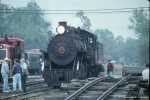 #18 almost looks alive with #14 working behind her.
#18 almost looks alive with #14 working behind her.
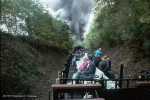 Behind #15, the Shade Gap Picnic Train passes through
Douglas Summit.
Behind #15, the Shade Gap Picnic Train passes through
Douglas Summit.
![]() #15 is backing the Shade Gap Picnic Train around the north leg
of the Colgate Grove Wye.
She is putting out quite an effort.
48.7 sec., 1.3 MB.
#15 is backing the Shade Gap Picnic Train around the north leg
of the Colgate Grove Wye.
She is putting out quite an effort.
48.7 sec., 1.3 MB.
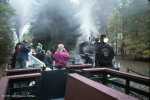 IT'S A TRAIN! SHOOT IT! #14 shows her good side to the spectators at
Colgate Grove.
IT'S A TRAIN! SHOOT IT! #14 shows her good side to the spectators at
Colgate Grove.
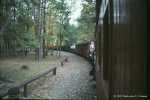 Now on the Freight Train at Colgate Grove,
#17 does the honors.
Now on the Freight Train at Colgate Grove,
#17 does the honors.
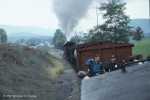 Returning to town, the view from the cupola is second to none.
Returning to town, the view from the cupola is second to none.
 The 1999 annual Whistle Salute ... In PANORAMA!
The 1999 annual Whistle Salute ... In PANORAMA!
![]() Here is the 'stepping whistles' part of the Saturday Whistle Salute.
48.7 sec., 0.76 MB.
Here is the 'stepping whistles' part of the Saturday Whistle Salute.
48.7 sec., 0.76 MB.
![]() This year, instead of a single combined blast, Joe Kovalchick lead
the locos in a 21 whistle salute. Here are the last 6 blasts.
25.0 sec., 0.23 MB.
This year, instead of a single combined blast, Joe Kovalchick lead
the locos in a 21 whistle salute. Here are the last 6 blasts.
25.0 sec., 0.23 MB.
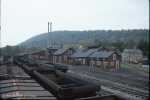 The Rockhill shops in an unusually uncluttered view.
The Rockhill shops in an unusually uncluttered view.
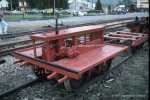 Here's a closer view of the restored MOW car.
Here's a closer view of the restored MOW car.
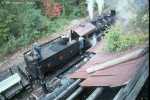 A thirsty #15 takes a deserved drink at the
South Standpipe while #12 waits by the
Coal Dock.
A thirsty #15 takes a deserved drink at the
South Standpipe while #12 waits by the
Coal Dock.
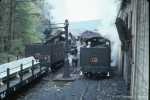 #15 and #12 prepare for the last set of day trains on Saturday.
#15 and #12 prepare for the last set of day trains on Saturday.
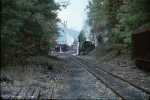 A sticky valve on the standpipe gives #12's tender trucks a washing. #15 and
the freight depart for the station as #12 awaits the next call to duty.
A sticky valve on the standpipe gives #12's tender trucks a washing. #15 and
the freight depart for the station as #12 awaits the next call to duty.
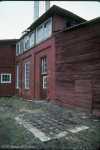 At the Boiler House the grate where coal
was dumped for the shop boilers is evident. There was likely a conveyor entering
the building where the rectangular patch is, dumping it into the coal bunker just
on the other side of the wall.
At the Boiler House the grate where coal
was dumped for the shop boilers is evident. There was likely a conveyor entering
the building where the rectangular patch is, dumping it into the coal bunker just
on the other side of the wall.
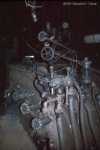 Inside #18 these are the backhead appliances on the engineer's side. The brake stand
is visible off to the right.
Inside #18 these are the backhead appliances on the engineer's side. The brake stand
is visible off to the right.
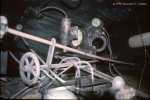 On top of the boiler is the steam gauge and the end of the throttle lever.
On top of the boiler is the steam gauge and the end of the throttle lever.
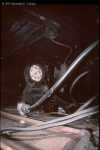 Here is the fireman's side of the boiler.
Here is the fireman's side of the boiler.
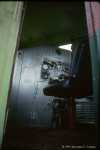 The control stand for M-7 is simple in comparison to #18's cab.
The control stand for M-7 is simple in comparison to #18's cab.
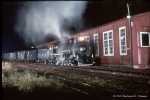 After the annual Night Train it was time for the Night Photo Session put on
by Steve Barry from Railfan Magazine.
It started raining
as the Night Train left the station and didn't let up any for the photographers.
So there were thirty five photographers with expensive cameras, Bounty paper towels
and plastic bags in the incessant rain. The security lights were turned off for the
exposure and the complete lack of light made focusing tricky at best. These are the
uncropped exposures.
After the annual Night Train it was time for the Night Photo Session put on
by Steve Barry from Railfan Magazine.
It started raining
as the Night Train left the station and didn't let up any for the photographers.
So there were thirty five photographers with expensive cameras, Bounty paper towels
and plastic bags in the incessant rain. The security lights were turned off for the
exposure and the complete lack of light made focusing tricky at best. These are the
uncropped exposures.
This is the first exposure. The headlight of #15 was on for about 3 seconds of a 30 second
exposure for that appearance. There were 8 or 10 hoppers on the train with coach
8 on the end, though you can not see it.
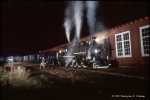 In the second exposure there was a period photographer added. Since this is the
uncropped version you can see the flash crew in the left part of the photo.
In the second exposure there was a period photographer added. Since this is the
uncropped version you can see the flash crew in the left part of the photo.
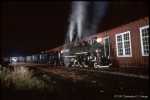 Stanley Hall did the honors on the pilot for the third shot.
Stanley Hall did the honors on the pilot for the third shot.
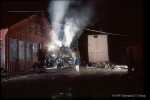 Dropping the train, #15 now poses between the
Sand House and the Boiler Shop. The
extra in the photo is an attempt to recapture the flavor of one of
O. Winston Link's classic night photos.
Dropping the train, #15 now poses between the
Sand House and the Boiler Shop. The
extra in the photo is an attempt to recapture the flavor of one of
O. Winston Link's classic night photos.
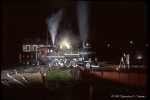 At this point we had to follow #15 as she headed back into the stall. She was
actively being cleaned during this exposure. As you can see, our period
photographer is back.
At this point we had to follow #15 as she headed back into the stall. She was
actively being cleaned during this exposure. As you can see, our period
photographer is back.
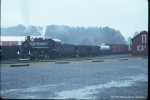 #17 lies in wait for the first two trains of the day to return for her to spring
into action. She had been sidelined the day before with a leaky flue, but it
turned out not to be too serious.
#17 lies in wait for the first two trains of the day to return for her to spring
into action. She had been sidelined the day before with a leaky flue, but it
turned out not to be too serious.
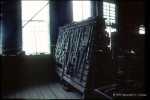 Every tool in the shops has a place.
Every tool in the shops has a place.
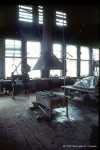 This is the forge for the Boiler House.
To the left is the hand shear and to the right a wood MOW car.
This is the forge for the Boiler House.
To the left is the hand shear and to the right a wood MOW car.
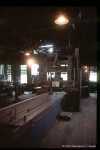 Dominating the Machine Shop is this massive
planer. It has a section of rail in it as a demonstration of the type of work
it performed.
Dominating the Machine Shop is this massive
planer. It has a section of rail in it as a demonstration of the type of work
it performed.
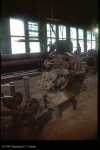 This little device is a scaler. It is used to flex locomotive flues just enough
to crack off the scale deposits left from less than pure boiler water.
This little device is a scaler. It is used to flex locomotive flues just enough
to crack off the scale deposits left from less than pure boiler water.
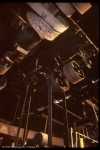 Above all the machines is a spider's web of overhead belts, pulleys and shafts.
Can you imagine having to keep these maintained and running six days a week?
Above all the machines is a spider's web of overhead belts, pulleys and shafts.
Can you imagine having to keep these maintained and running six days a week?
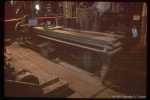 This is the brake cylinder lathe.
This is the brake cylinder lathe.
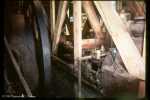 This is a closeup of the shops steam engine. To the right is the cylinder,
to the left the main pulley and flywheel. Under the wood cribbing is the main
rod and in front of it is the valve gear. The cribbing is helping to support
the roof beam between the Machine Shop
and Boiler House.
This is a closeup of the shops steam engine. To the right is the cylinder,
to the left the main pulley and flywheel. Under the wood cribbing is the main
rod and in front of it is the valve gear. The cribbing is helping to support
the roof beam between the Machine Shop
and Boiler House.
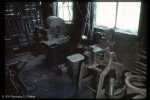 These two grinders are in the rear of the
Machine Shop.
These two grinders are in the rear of the
Machine Shop.
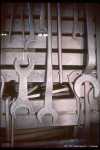 There is no question where this wrench belongs.
There is no question where this wrench belongs.
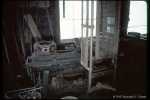 This bolt threader is in the rear of the
Machine Shop.
This bolt threader is in the rear of the
Machine Shop.
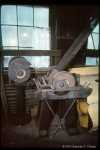 In the Boiler Shop are many grinding tools.
Here are two in the rear of the shop.
In the Boiler Shop are many grinding tools.
Here are two in the rear of the shop.
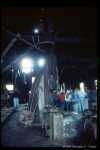 In the Blacksmiths Shop this is the backside
of the big Steam Hammer.
In the Blacksmiths Shop this is the backside
of the big Steam Hammer.
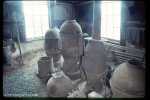 These pot-belly stoves were assembled from parts lying about in the
Foundry.
These pot-belly stoves were assembled from parts lying about in the
Foundry.
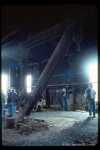 This is the Foundry Gantry for moving
the casting boxes.
This is the Foundry Gantry for moving
the casting boxes.
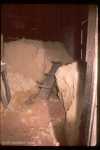 The Foundry's Sand Room stores the special casting
sand used with the wood patterns.
The Foundry's Sand Room stores the special casting
sand used with the wood patterns.
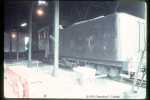 #16 did not venture out this year, but that didn't keep me from trying to get
a shot of her too.
#16 did not venture out this year, but that didn't keep me from trying to get
a shot of her too.
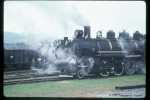 #15, #12 and #14 (l to r) are lined up for the Sunday Whistle Salute. They did the more
traditional 'mass' toot' instead of the 21 whistle salute as on Saturday.
#15, #12 and #14 (l to r) are lined up for the Sunday Whistle Salute. They did the more
traditional 'mass' toot' instead of the 21 whistle salute as on Saturday.
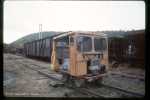 Here again is Phil Raynes' former EBT Fairmont motor car, parked at the ready
to be loaded onto his trailer.
Here again is Phil Raynes' former EBT Fairmont motor car, parked at the ready
to be loaded onto his trailer.
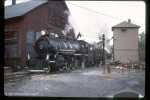 #14 waits her turn over the inspection pit as #15 steams impatiently behind.
#14 waits her turn over the inspection pit as #15 steams impatiently behind.
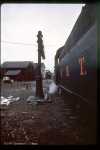 #15 is now at the inspection pit while #14 is getting a grate cleaning ahead at the
ash pit.
#15 is now at the inspection pit while #14 is getting a grate cleaning ahead at the
ash pit.
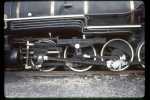 Here is a closeup of #15's Walschearts valve gear. Compare it to #17's photo above.
Here is a closeup of #15's Walschearts valve gear. Compare it to #17's photo above.
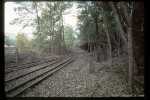 In Mount Union the EBT main is clear all the way to the NS main.
In Mount Union the EBT main is clear all the way to the NS main.
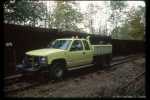 Mount Union Connecting's first piece of equipment rolls down the main to
an appointment at the enginehouse.
Mount Union Connecting's first piece of equipment rolls down the main to
an appointment at the enginehouse.
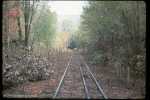 Below the gaze of Jacks Mountain, the hi-railer approaches the enginehouse
switch.
Below the gaze of Jacks Mountain, the hi-railer approaches the enginehouse
switch.
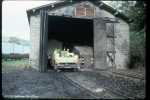 The hi-railer shoves a small office on a trailer into #6's stall in the
Mount Union Enginehouse.
The hi-railer shoves a small office on a trailer into #6's stall in the
Mount Union Enginehouse.
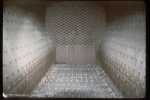 Inside the enginehouse #3 waits for the next call to duty. This view inside her
firebox shows she received a good cleaning after she made the last common carrier
EBT movement in 1956.
Inside the enginehouse #3 waits for the next call to duty. This view inside her
firebox shows she received a good cleaning after she made the last common carrier
EBT movement in 1956.
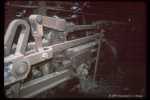 This is the engineers side Walschearts valve gear. Above in the photo one could see
#3 has a power reverse (the cylinder in the photo helped move the valve gear from
forward to reverse and in between).
This is the engineers side Walschearts valve gear. Above in the photo one could see
#3 has a power reverse (the cylinder in the photo helped move the valve gear from
forward to reverse and in between).
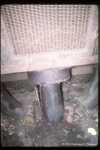 This one-handed shot of the interior of #3's smokebox shows that, unlike the firebox,
it did not get cleaned out. This part of the loco was also exposed to the elements
when the roof of the enginehouse deteriorated.
This one-handed shot of the interior of #3's smokebox shows that, unlike the firebox,
it did not get cleaned out. This part of the loco was also exposed to the elements
when the roof of the enginehouse deteriorated.
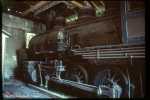 Unlike #6 which has the main rod connected to the middle driver, #3's is connected
to the rear driver, likely to make room for the external valve gear. Compare this
to #6 from the same angle.
Unlike #6 which has the main rod connected to the middle driver, #3's is connected
to the rear driver, likely to make room for the external valve gear. Compare this
to #6 from the same angle.
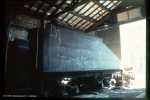 #3's tender still proudly displays her owner's initials.
#3's tender still proudly displays her owner's initials.
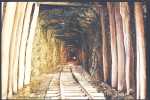 Sideling Hill Tunnel under bright lights and
a REALLY long exposure.
Sideling Hill Tunnel under bright lights and
a REALLY long exposure.
|
HOME |
The East Broad Top Railroad Homepage © 1994-2003 Christopher D. Coleman All rights reserved Site Information Top of this page |
|---|